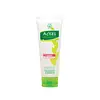What's inside
What's inside
 Key Ingredients
Key Ingredients

 Benefits
Benefits

 Concerns
Concerns

 Ingredients Side-by-side
Ingredients Side-by-side

Water
Skin ConditioningGlycerin
HumectantTranexamic Acid
AstringentSodium Cocoyl Glycinate
CleansingSoy Amino Acids
Skin ConditioningLauryl Betaine
CleansingHydroxypropyl Starch Phosphate
Citric Acid
BufferingHyaluronic Acid
HumectantPEG-60 Glyceryl Isostearate
Sodium Chloride
MaskingGlyceryl Stearate Se
EmulsifyingCoco-Glucoside
CleansingPhenoxyethanol
PreservativeSodium Cocoyl Isethionate
CleansingSodium Phytate
Ethylhexylglycerin
Skin ConditioningPolyquaternium-7
1,2-Hexanediol
Skin ConditioningQuillaja Saponaria Bark Extract
CleansingSodium Benzoate
MaskingCeramide NP
Skin ConditioningCeramide EOP
Skin ConditioningCeramide AP
Skin ConditioningCentella Asiatica Extract
CleansingNiacinamide
SmoothingCeramide As
Skin ConditioningPanthenol
Skin ConditioningCeramide Ns
Skin ConditioningArginine
MaskingButylene Glycol
HumectantHydrogenated Lecithin
EmulsifyingCetearyl Alcohol
EmollientTocopherol
AntioxidantStearic Acid
CleansingAscorbic Acid
AntioxidantSodium Hyaluronate
HumectantCholesterol
EmollientPhytosphingosine
Skin ConditioningWater, Glycerin, Tranexamic Acid, Sodium Cocoyl Glycinate, Soy Amino Acids, Lauryl Betaine, Hydroxypropyl Starch Phosphate, Citric Acid, Hyaluronic Acid, PEG-60 Glyceryl Isostearate, Sodium Chloride, Glyceryl Stearate Se, Coco-Glucoside, Phenoxyethanol, Sodium Cocoyl Isethionate, Sodium Phytate, Ethylhexylglycerin, Polyquaternium-7, 1,2-Hexanediol, Quillaja Saponaria Bark Extract, Sodium Benzoate, Ceramide NP, Ceramide EOP, Ceramide AP, Centella Asiatica Extract, Niacinamide, Ceramide As, Panthenol, Ceramide Ns, Arginine, Butylene Glycol, Hydrogenated Lecithin, Cetearyl Alcohol, Tocopherol, Stearic Acid, Ascorbic Acid, Sodium Hyaluronate, Cholesterol, Phytosphingosine
Water
Skin ConditioningGlycerin
HumectantPalmitic Acid
EmollientGlyceryl Stearate
EmollientMyristic Acid
CleansingPotassium Hydroxide
BufferingLauric Acid
CleansingButylene Glycol
HumectantOlea Europaea Fruit Oil
MaskingLauramide DEA
Potassium Cocoyl Glycinate
Lauryl Hydroxysultaine
CleansingPotassium Chloride
Alcohol Denat.
AntimicrobialParfum
MaskingCI 77891
Cosmetic ColorantTocopheryl Acetate
AntioxidantO-Cymen-5-Ol
AntimicrobialDipotassium Glycyrrhizate
HumectantArctostaphylos Uva-Ursi Leaf Extract
Skin ConditioningMagnesium Ascorbyl Phosphate
AntioxidantLactic Acid
BufferingArbutin
AntioxidantSodium Acetylated Hyaluronate
HumectantWater, Glycerin, Palmitic Acid, Glyceryl Stearate, Myristic Acid, Potassium Hydroxide, Lauric Acid, Butylene Glycol, Olea Europaea Fruit Oil, Lauramide DEA, Potassium Cocoyl Glycinate, Lauryl Hydroxysultaine, Potassium Chloride, Alcohol Denat., Parfum, CI 77891, Tocopheryl Acetate, O-Cymen-5-Ol, Dipotassium Glycyrrhizate, Arctostaphylos Uva-Ursi Leaf Extract, Magnesium Ascorbyl Phosphate, Lactic Acid, Arbutin, Sodium Acetylated Hyaluronate
Ingredients Explained
These ingredients are found in both products.
Ingredients higher up in an ingredient list are typically present in a larger amount.
Butylene Glycol (or BG) is used within cosmetic products for a few different reasons:
Overall, Butylene Glycol is a safe and well-rounded ingredient that works well with other ingredients.
Though this ingredient works well with most skin types, some people with sensitive skin may experience a reaction such as allergic rashes, closed comedones, or itchiness.
Learn more about Butylene GlycolGlycerin is already naturally found in your skin. It helps moisturize and protect your skin.
A study from 2016 found glycerin to be more effective as a humectant than AHAs and hyaluronic acid.
As a humectant, it helps the skin stay hydrated by pulling moisture to your skin. The low molecular weight of glycerin allows it to pull moisture into the deeper layers of your skin.
Hydrated skin improves your skin barrier; Your skin barrier helps protect against irritants and bacteria.
Glycerin has also been found to have antimicrobial and antiviral properties. Due to these properties, glycerin is often used in wound and burn treatments.
In cosmetics, glycerin is usually derived from plants such as soybean or palm. However, it can also be sourced from animals, such as tallow or animal fat.
This ingredient is organic, colorless, odorless, and non-toxic.
Glycerin is the name for this ingredient in American English. British English uses Glycerol/Glycerine.
Learn more about GlycerinWater. It's the most common cosmetic ingredient of all. You'll usually see it at the top of ingredient lists, meaning that it makes up the largest part of the product.
So why is it so popular? Water most often acts as a solvent - this means that it helps dissolve other ingredients into the formulation.
You'll also recognize water as that liquid we all need to stay alive. If you see this, drink a glass of water. Stay hydrated!
Learn more about Water